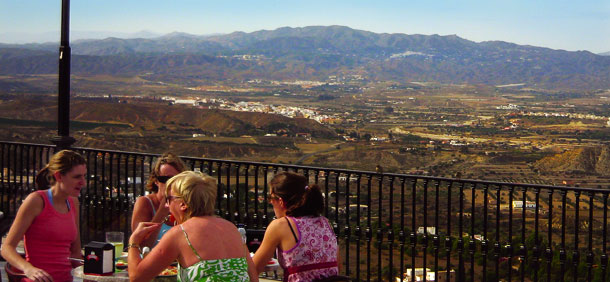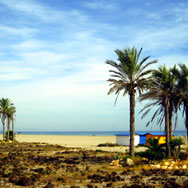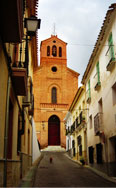- Villa search

- Canaries
- Caribbean
- Croatia, Bulgaria and Hungary
- Cyprus
- Florida
- France and Corsica
- Greece
- Italy
- Lakes and Mountains
- Madeira
- Malta and Gozo
- Portugal
- South Africa
- Spain - Balearics

View from Mojácar across the Valley de las Pirámides
A taste of the high life
Harry Glass took to the hills for a villa holiday on Spain’s Costa de Almería
Ever thought about staying in a hilltop holiday home? A seaside villa is the popular preference, but when you have a pool and balcony views to die for, it’s hard to imagine life gets any better. Take a sierra stay on the Costa de Almería and you’re still within a 15-minute drive of miles of sandy beaches, so you get the best of both worlds – coast and country.

Gurrucha’s beach
We chose a villa near Bedar, a tiny town of whitewashed houses in the foothills of the Sierra de los Filabres. It’s ten miles inland from Mojácar Playa, the main resort at the east end of the costa, which has all the amenities – bars, restaurants, watersports centres – without the high-rise smudges on the skyline. It’s flanked by Carboneras and Garrucha, with their own huge beaches, and all retain a very Spanish feel.
Traditional hill towns
The narrow streets that take you into many Spanish hill towns are steep ramps that hoist you from dusty, winding roads into crescents of white buildings. Bedar’s entrance is no exception. It’s a sort of Iberian ‘beam me up, Scotty’. Within seconds of wondering whether you missed your turning, you’re admiring walls of bougainvillea, geraniums of purple and red, and gasping at panoramic views.

Lubrín
There’s enough here to provide fuel for lazy days and nights. There’s a market on Wednesdays, and twice weekly a fishmonger drives through town, honking his horn. People often buy something just to shut him up. The popular Mirador restaurant serves one of the best paellas for miles around. La Fuente is run by an American who cooks good homemade pasta and grows ingredients in his garden. There are three or four bars. At one, we bought a couple of particularly cheap rounds of the local Cruzcampo beer.
Bedar was once busier, its population swelling to 5,000 back in the 19th and early 20th centuries on the back of the nearby lead and iron mines. It’s now 700. Cornish tin miners were among those who came to make money, and one of them became the town’s mayor. The mines closed in 1958, but the statue of a man – pickaxe in hand – in the plaza, and remains of workers’ houses and a mining railway track, keep Bedar’s history from being buried.

Craft quarter, Níjar
home | destinations and editorial | villa search | property for sale | car hire | flights | services
villaseek blog | contact villaseek | links and resources | advertise your villa© Dune Root Ltd and Villaseek.com 2012 - Caribbean
- Canaries